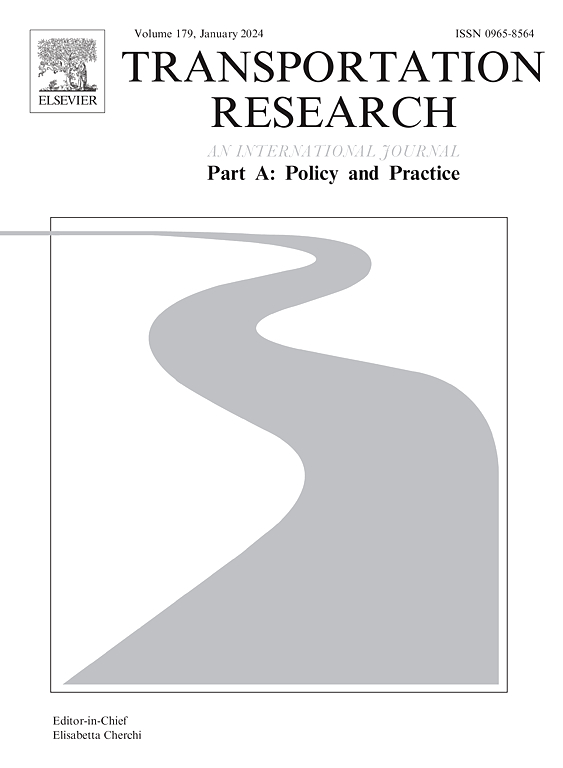远程办公对户外时间使用和访问地点多样性的影响:来自 COVID-19 大流行病的证据
IF 6.3
1区 工程技术
Q1 ECONOMICS
Transportation Research Part A-Policy and Practice
Pub Date : 2024-10-02
DOI:10.1016/j.tra.2024.104276
引用次数: 0
摘要
COVID-19 大流行导致旅行和活动行为发生了不可预见的变化,其中最突出的是各行各业广泛采用远程办公。本文研究了电子通勤对时间使用和独特访问地点数量的影响,这两项因素已被证明与幸福感密切相关。以往的远程办公研究通常依赖于横截面数据,很难控制未观察到的混杂因素,只能分析每日时间使用的影响,而且尚未量化远程办公对访问地点多样性的影响。我们使用准实验设计来控制未观察到的混杂因素,并扩展先前的研究,以确定电子通勤对时间使用的日常影响在周层面上是叠加性的还是替代性的。我们使用了 2020 年 1 月至 2022 年 9 月期间被动收集的兴趣点 (POI) 数据,并辅以 COVID-19 大流行期间的五波调查反馈(2020 年 8 月、2020 年 10 月、2020 年 12 月、2021 年 4 月和 2021 年 7 月),这些数据来自美国智能手机用户面板。我们发现,在电子通勤日,工人在家庭以外的非工作地点花费的时间明显增加,在 COVID-19 大流行之前估计为 114 分钟,在大流行的早期阶段减少到 63 分钟,到 2022 年恢复到大约 120 分钟,这些估计值在以往文献的估计值范围之内。现有文献侧重于单日分析,而我们的周分析表明,电子通勤导致的每日差异是替代性的,在周层面上,多一天电子通勤对时间使用的影响是无效的。我们延伸分析了电子通勤对独特访问地点数量的影响,结果显示,电子通勤每增加一天,每周独特访问地点数量平均减少 0.35 个。总之,我们的研究结果表明,虽然电子通勤并不会减少每周在家庭以外的非工作地点花费的总体时间,但会减少每周这些地点的多样性。本文章由计算机程序翻译,如有差异,请以英文原文为准。
Influence of telecommuting on out-of-home time use and diversity of locations visited: Evidence from the COVID-19 pandemic
The COVID-19 pandemic has led to unforeseen changes in travel and activity behavior, most notably the wide adoption of telecommuting across various sectors of the workforce. This paper investigates the impact of telecommuting on time use and the number of unique locations visited, both of which have been shown to be closely linked to well-being. Previous telecommuting research often relies on cross-sectional data for which it is difficult to control for unobserved confounding, only analyzes impacts of time-use at the daily level, and has yet to quantify the impact of telecommuting on diversity of locations visited. We use quasi-experimental designs to control for unobserved confounders and extend previous research to identify whether the daily impacts of telecommuting on time-use are additive or substitutional at the weekly level. We use passively collected Point of Interest (POI) data between January 2020 and September 2022, supplemented by five waves of survey responses throughout the COVID-19 pandemic (August 2020, October 2020, December 2020, April 2021, and July 2021) from a panel of U.S. smartphone users. We find that on telecommuting days, workers spend significantly more time at out-of-home non-work locations, estimated to be 114 min prior to the COVID-19 pandemic, decreasing in the early stages of the pandemic to 63 min, and recovering to approximately 120 min in 2022, estimates that are within the range of estimates presented in previous literature. While existing literature focuses on single day analyses, our weekly analysis suggests that daily differences due to telecommuting are substitutional, with the effect of an additional day of telecommuting on time-use at the weekly level being null. Our extension to analyze the impacts of telecommuting on the number of unique locations visited shows that an additional day of telecommuting results in an average decrease of 0.35 in the number of unique weekly locations visited. Collectively, our findings suggest that while telecommuting does not diminish the overall weekly time spent at out-of-home non-work locations, it decreases the diversity of such locations on a weekly level.
求助全文
通过发布文献求助,成功后即可免费获取论文全文。
去求助
来源期刊
CiteScore
13.20
自引率
7.80%
发文量
257
审稿时长
9.8 months
期刊介绍:
Transportation Research: Part A contains papers of general interest in all passenger and freight transportation modes: policy analysis, formulation and evaluation; planning; interaction with the political, socioeconomic and physical environment; design, management and evaluation of transportation systems. Topics are approached from any discipline or perspective: economics, engineering, sociology, psychology, etc. Case studies, survey and expository papers are included, as are articles which contribute to unification of the field, or to an understanding of the comparative aspects of different systems. Papers which assess the scope for technological innovation within a social or political framework are also published. The journal is international, and places equal emphasis on the problems of industrialized and non-industrialized regions.
Part A''s aims and scope are complementary to Transportation Research Part B: Methodological, Part C: Emerging Technologies and Part D: Transport and Environment. Part E: Logistics and Transportation Review. Part F: Traffic Psychology and Behaviour. The complete set forms the most cohesive and comprehensive reference of current research in transportation science.

 求助内容:
求助内容: 应助结果提醒方式:
应助结果提醒方式:


